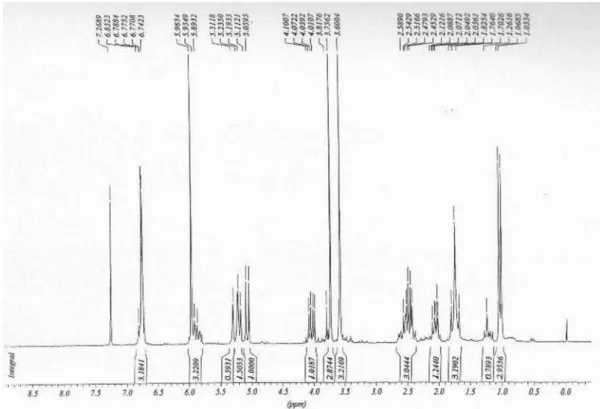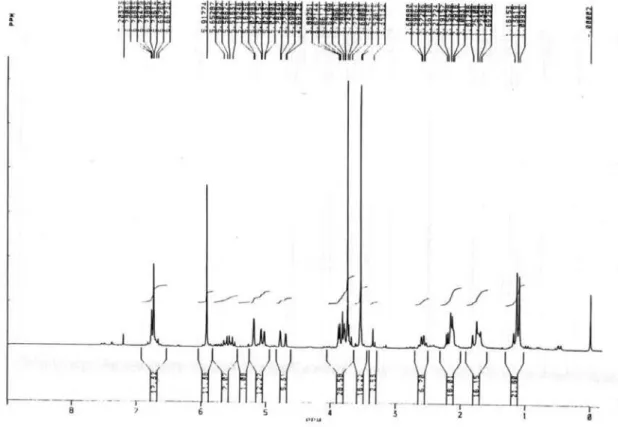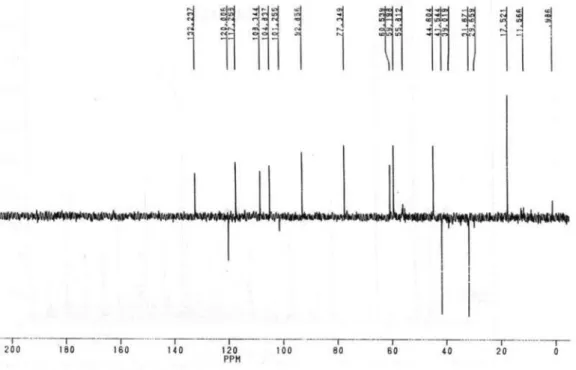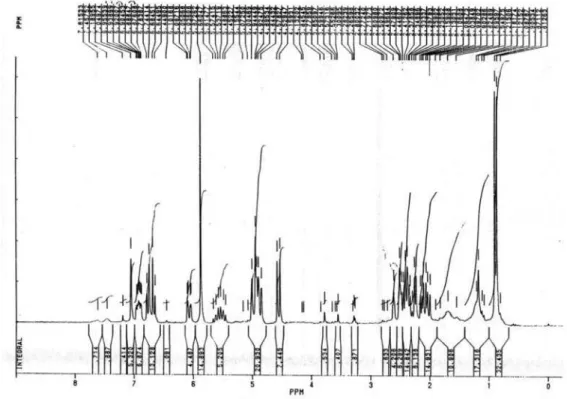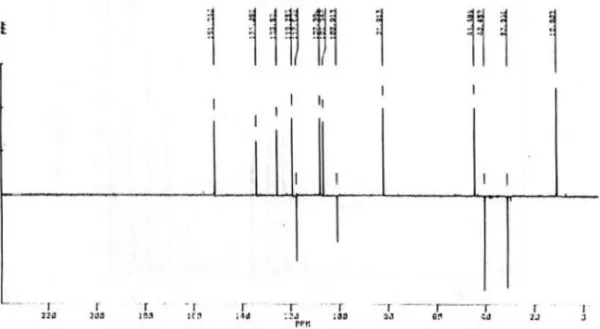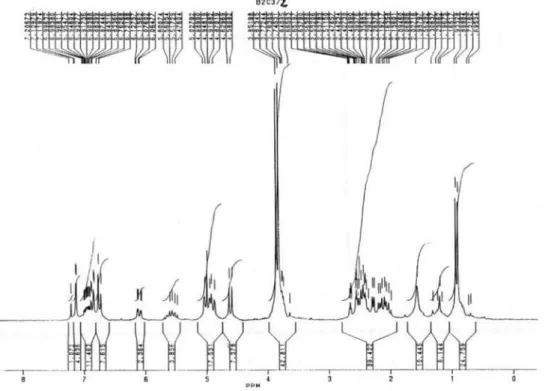Article
J. Braz. Chem. Soc., Vol. 20, No. 5, 853-859, 2009. Printed in Brazil - ©2009 Sociedade Brasileira de Química 0103 - 5053 $6.00+0.00
*e-mail: majokato@iq.usp.br
Neolignans and Sesquiterpenes from Leaves and Embryogenic Cultures
of
Ocotea catharinensis
(Lauraceae)
Mariko Funasaki,a Ana Luísa L. Lordello,b Ana Maria Viana,c Claudete Santa-Catarina,d Eny I. S. Floh,d Massayoshi Yoshidaa,e and Massuo J. Kato*,a
aInstituto de Química, Universidade de São Paulo, CP 26077, 05513-970 São Paulo-SP, Brazil
bDepartamento de Química, Universidade Federal do Paraná, CP 19081, 81531-990 Curitiba-PR, Brazil
cDepartamento de Botânica, Centro de Ciências Biológicas, Universidade Federal de Santa Catarina,
88040-900 Florianópolis-SC, Brazil
dInstituto de Biociências, Universidade de São Paulo, CP 11461, 05508-900 São Paulo-SP, Brazil
eCentro de Biotecnologia da Amazônia, Av. Gov. Danilo de Matos Areosa, 690, 69075-351 Manaus-AM, Brazil
Foram isoladas de extratos de folhas de Ocotea catharinensis Mez (Lauraceae) quatorze neolignanas sendo nove benzofurânicas (incluindo três novas substâncias 1e, 2f e 4b), uma seco -benzofurânica inédita (3b), duas biciclo[3.2.1]octânicas (incluindo a nova 5c), dois novos dímeros biciclo[3.2.1]octânicos (7a e 7b) e ainda dois sesquiterpenos (incluindo o novo humulanol 9). Nos embriões somáticos de O. catharinensis foram identificadas sete neolignanas incluindo uma nova neolignana biciclo[3.2.1]octânica (4a).
The extracts from leaves of Ocoteacatharinensis Mez (Lauraceae) were found to contain fourteen neolignans and two sesquiterpenes: nine benzofuran types (including three new compounds
1e, 2f and 4b), one new seco-benzofuran type (3b), two bicyclo[3.2.1]octane types (including the new compound 5c), two new dimers of bicyclo[3.2.1]octane type (7a and 7b) and two sesquiterpenes (including a new humulanol 9). In addition, seven neolignans were also showed to occur in somatic embryos of O. catharinensis including one new bicyclo[3.2.1]octane type (4a).
Keywords:Ocotea catharinensis, benzofuran neolignans, bicyclo[3.2.1]octane neolignans,
humulane sesquiterpene, somatic embryos
Introduction
Ocotea catharinensis (Lauraceae) is a woody plant species found in southern Atlantic forest in Brazil, which produces excellent quality of timber. The extensive logging over the past thirty years associated with difficulties for propagation has led its natural population to be significant decrease. Since O. catharinensis has been included as endangered species, a somatic embryogenic system was developed aiming to a massive propagation.1,2
The Ocotea has been one of the most phytochemically investigated Lauraceous genus and their major secondary compounds were showed to be phenylpropanoid-derived including several sub-classes of neolignans.3 Previous phytochemical studies carried out in leaves
of O. catharinensis collected at Horto Florestal (Serra da Cantareira), São Paulo State, Brazil, reported the occurrence of benzofuran (1b, 1c, 1d, 2b, 2c, 2d, 2e and 2h) and bicyclo[3.2.1]octane (5a, 5b and 5d) neolignans.4 Representatives of both sub-classes of neolignans have also been previously isolated from barks and woods of a specimen collected in São Paulo State,5,6 and also from wood and leaves of O. porosa (“imbuia”) collected in Rio Grande do Sul State, southern Brazil.7-9
Neolignans and Sesquiterpenes from Leaves and Embryogenic Cultures of Ocotea catharinensis J. Braz. Chem. Soc.
854
spathulenol (8)4,14 were isolated as well. The embryogenic cultures were shown to contain a new benzofuran neolignan 4a, six already known benzofuran 1c,6,121d,62a,6,10,112b,11,12 2e,6 and a bicyclo[3.2.1]octaneneolignan 6.15
Results and Discussion
The defatted fraction of hexane extracts from
O. catharinensis leaves and from O. catharinensis
somatic embryos were submitted to flash chromatography
followed by prep. TLC and/or circular chromatography (Chromatotron®). This procedure yielded nine new compounds (1e, 2f, 3b, 4a, 4b, 5c, 7a, 7b and 9), besides armenin-B (1a),6,10 1c,6,12 5’-methoxyporosin (1d),6 ferrearin-C (2a),6,10,11 ferrearin-B (2b),11,122d,4 ferrearin-E (2e),6 ferrearin-G (2g),12 5e,13615 andspathulenol (8).4,14
Funasaki et al. 855 Vol. 20, No. 5, 2009
O. catharinensis.6The only difference was assigned to the oxygenation pattern of the aromatic ring, which was determined as 3,4,5-trimethoxyphenyl in 1e instead of 3,4-methylenedioxyphenyl in 1a.
The 1H NMR spectra of 2f (C
21H26O6) and of ferrearin-E (2e) (C20H24O5) isolated from O. catharinensis6were similar. The difference between both compounds consisted of an additional methoxyl group at β-position (C-5’,
d169.3) of 2f.
The molecular formula of compound 3b was determined by HRESI as C22H28O6. All the 1H NMR data was similar to that of a neolignan 3a (C21H26O5) previously isolated from O. porosa.16 Nevertheless, the 1H and 13C NMR spectra indicated that 3b contained a methoxyl group at
C-3’ (dH 3.58, dC 55.7) which was evidenced by the signal of C-3’ at dC 152.8 instead of dC 132.7 in 3a. Its absolute configuration was determined as 8S,1’R,5’R based on the signal of optical rotation ([a]D21 = −17o (MeOH,
c = 0.92 g/100mL) and comparison with reported data for (–)-megaphone in which X-ray crystallographic studies was carried out.16
The compounds 4a and 4bwere characterized as hexahydrobenzofuran neolignans by analysis of their 1H and 13C NMR spectra and comparison with 4c which was previously isolated from O. porosa.9 The aromatic rings were determined as 3,4-methylenedioxyphenyl and 5-methoxy-3,4-methylenedioxyphenyl for 4a and 4b, respectively. The relative stereochemistry between methyl and aryl groups Table 1. 1H and 13C NMR data of 1e, 2f, 3b, 4a, 4b and 6 [d, J (Hz), 200 MHz and 50 MHz, CDCl
3]
position 1e 2f 3b 4a 4b 6
1H 13C 1H 13C 1H 13C 1H 1H 13C 13C
1 131.8 131.3 131.3 132.5 129.4
2 6.34 (brs) 102.5 6.63-6.76 (m) 110.8 7.38 (d, 2.0) 109.9 6.99 (d,1.5) 6.45 (brs) 106 113.9
3 153.4 148.2 148.7 148 148.2
4 136.1 148.6 149.9 134.2 147.3
5 153.3 6.63-6.76 (m) 109.7 6.80 (d, 8.4) 110.8 6.64 (d, 7.8) 143.1 110.6
6 6.45 (brs) 101.1 6.63-6.76 (m) 118.5 7.52 (dd, 8.4; 2.0) 122.8 6.73 (dd, 7.8; 1.5) 6.42 (brs) 106 122.8
7 5.20 (d, 1.9) 92.5 5.36 (d, 9.3) 82.4 202.3 4.43 (d, 9.9) 5.33 (d, 9.7) 82.3 57.1
8 2.37-2.66 (m) 44.3 2.75 (m) 43.2 4.0 (q, 7.5) 42.4 2.18-2.40 (m) 2.72 (d, 9.6) 43.3 49.1
9 1.15 (d, 7.4) 17.7 0.52 (d, 7.4) 11.4 1.10 (d, 7.5) 12.5 0.84 (d, 6.8) 0.57 (d, 7.5) 12.4 13.8
1’ 47.3 51.6 50.4 49.9 50.8
2’ 31.6 100.9 196.5 102 77.4
3’ 77.3 196.9 152.8 152.5 89.9
4’ 192.5 5.39 (s) 102.4 5.72 (brs) 132.9 4.78 (brs) 4.92 (brs) 97.5 193.7
5’ 3.93 (dd, 12.1; 5.0) 132.3 169.3 4.3 (m) 72.8 4.03-4.12 (m) 4.08-4.13 (m) 74.3 151.8
6’ 1.82 (dd, 12.0; 12.0) 169.7 2.45 (d, 16.5) 41.7 2.80 (dd, 12.9; 9.9) 34.6 2.00 (dd, 12.6; 5.0) 1.90 (dd, 12.3; 4.8) 31.7 119.3
2.09-2.25 (m) 2.20 (dd, 12.9; 5.3) 1.40 (dd, 12.6; 10.0) 1.46 (dd, 10.0; 10.0)
7’ 2.09-2.25 (m) 41.3 2.31 (dd, 7.3; 5.5) 40.1 2.50 (dd, 14.4; 6.4) 39 2.18-2.40 (m) 2.43 (dd, 14.2; 7.1) 38.4 36.9
2.30 (dd, 14.4; 8.8) 2.23 (dd, 14.2; 7.9)
8’ 5.54-5.65 (m) 132.3 5.64-5.73 (m) 133.4 5.58-5.68 (m) 132.9 5.86-5.95 (m) 5.90-5.95 (m) 135 133.8
9’ 5.03 (dd, 14.6; 1.4) 120 5.00 (dd, 15.3; 1.9) 118.7 5.05 (dd, 12.0; 2.0) 118.6 5.03 (dd, 14.8; 1.8 5.12 (dd, 14.4; 1.8) 117.5 118.8
4.72 (dd, 11.2; 1.4) 4.93 (dd, 10.0; 1.9) 5.03 (dd, 14.8; 1.8 5.08 (dd, 7.7; 1.8)
CH2O2 5.86 (s) 5.92 (s) 101.3
MeO-3 3.80 (s) 60.9 3.79 (s) 55.8 3.82 (s) 55.9 55.8
MeO-4 3.81 (s) 60.5 3.78 (s) 55.9 3.86 (s) 55.8 55.7
MeO-5 3.82 (s) 60.9 3.85 (s) 56.7
MeO-3’ 3.73 (s) 59.3 3.58 (s) 55.7 3.61 (s) 3.67 (s) 55.8 54.7
MeO-4’ 3.34 (s) 55
MeO-5’ 3.56 (s) 55.9 3.75 (s) 55.6 3.34 (s) 3.37 (s) 55.1 55.5
OH-2’ 3.66 (s)
Neolignans and Sesquiterpenes from Leaves and Embryogenic Cultures of Ocotea catharinensis J. Braz. Chem. Soc.
856
was deduced from the anisotropic shielding effect caused by aromatic ring on cis methyl hydrogens as observed in the 1H NMR spectra. The methyl (H-9) signals of 4a (trans) and 4b (cis) were observed at d 0.84 (d, 6.8 Hz) and 0.57 (d, 7.5 Hz), respectively. The placement of hydroxyl group at C-2’ and methoxyl group at C-3’ were possible by comparison of 13C NMR data and those described for 4c.9
The molecular formula of compound 5c was determined by HRESI as C21H22O6. Its 1H NMR were similar to that observed for previously reported 5e (C22H24O7) isolated from Aniba simulans,13 but with a 3,4-methylenedioxy for 5c instead of 5-methoxy-3,4-methylenedioxy observed for 5e.
Compounds 7a and 7b had their structures determined by analysis of their IR, MS and NMR spectra. The IR spectra of 7a/7b exhibited absorption bands at 1766 and 1714 cm-1, assignable to two carbonyl groups for each compound. Their 1H and 13C NMR spectra resembled those of 5c/5e, respectively. Nevertheless, the 13C NMR signals associated to the olefinic double bond at C5´-C6´ were replaced by signals of quaternary carbinolic and methine signals at
d88.4/52.6 (7a) and d 88.4/52.7 (7b), respectively. The EIMS of 7a/7b showed molecular ion at m/z 370 and 400, but the chemical ionization mass spectrometry (CIMS) provided a molecular ion peak (M + H)+ at m/z 741 and
m/z 801, respectively. These molecular ions combined with 1H and 13C NMR (PND and DEPT 135°), suggested a molecular formula C42H44O12 and C44H48O14 compatible with dimeric structures. Thus, the fragmentary ion peaks found at m/z 371 of 7a and 401 of 7b were assigned to the cleavage into monomers indicating that 7a and 7b were symmetric dimers of 5a and 5e. Based on similarities to 5a and 5e all 1H and 13C NMR data were assigned with the aid of 1H-1H COSY and HETCOR spectra (Table 2). In order to determine the relative stereochemistry at the cyclobutane ring, NOESY spectra showed cross-peaks between H-8 and H-7’, H-7’ and H-6’, H-6’ and OMe-5’. Thus, among the cyclobutane syn-adducts at C-5’ and C-6’ four dimers would be expected (Figure 1). Dimers III and IV having cis configuration at the cyclobutane would involve a considerable steric hindrance between the bulky groups of bicyclooctane neolignan, which would prevent such arrangement. For these reason, dimers I and II having
trans configuration were considered as the mostly probable structures.
The molecular formula of 9 (C15H26O) was deduced from MS and 13C NMR (PND and DEPT 135°) spectral data. The spectral characteristics of compound 9 were closely related to those of a-humulane17 except for the existence of a hydroxyl group (IR νmax/cm-1: 3425) and two double bonds instead of three. All the 1H and 13C NMR signalswere assigned by 1H-1H
COSY and HETCOR techniques and were compatible with the structure depicted for humula-4,8-dien-2-ol (9).
The leaves of O. catharinensis collected in São Paulo and in Santa Catarina were showed to contain both benzofuran and bicyclo[3.2.1]octane type neolignans. The benzofuran neolignan 1d was the major compound in the leaves collected in São Paulo while bicyclo[3.2.1]octane neolignans 5e/5c were predominant in Santa Catarina specimen. The embryogenic cultures also produced both types of neolignans, but 1d was the major compound.
Experimental
General
Prep. TLC was carried out on silica gel PF-254 (Merck) and CC on silica gel 60H (0.005-0.045 mm) (Merck). Optical rotations were measured on Jasco Mod. DIP-370. 1H and 13C NMR spectra were registered on a Bruker AC-200 spectrometers using CDCl3 as solvent and TMS as internal standard. EIMS (70 eV) and CIMS (methane) were obtained on a HP 5988-A spectrometer. HRESIMS (positive mode) were recorded on a Bruker Daltonics microTOF. Elemental analysis were performed on a Perkin-Elmer CHN Elemental Analyser 2400. HPLC were performed on Gilson 321 using a reverse phase column (Supelco, C-18, 4.6 × 250 mm, 5 µm).
Plant material
The leaves of the O. catharinensis were collected in Brusque, Santa Catarina State, Brazil in June 1993. The species was collected and identified by Prof. Ademir Reis (Departamento de Botânica, UFSC). The voucher specimen (FLOR-17560) was deposited in the FLOR Herbarium (UFSC).
Funasaki et al. 857 Vol. 20, No. 5, 2009
Initiation and multiplication of embryogenic cultures
Embryogenic cultures were initiated from mature zygotic embryos of O. catharinensis according to described methodology.1,2
The somatic embryos produced at early cotyledonary stage (2-3 mm length) were inoculated in Woody Plant Medium (WPM, Sigma Co., USA) supplemented with 22.7 g L-1 sorbitol, 2 g L-1 Phytagel, 20 g L-1 sucrose and 400 mg L-1 glutamine (pH 5.8) and maintained at 25 °C and with photon flux of 22 µmol m-2 s-1 provided by fluorescent tubes under 16 h photoperiod.2,18 After four weeks cultivation the somatic embryos at mature stage (≥ 5 mm) were transferred to Petri dishes (6 cm), spread over two filter papers, and maintained at 25 °C for 4 days for desiccation.
Extraction and isolation of the constituents from leaves
Dried and powdered leaves (395.0 g) were exhaustively extracted with hexane at room temp. Evaporation of the Table 2. 1H and 13C NMR of compounds 5c, 5e, 7a and 7b [d, J (Hz), 200 MHz and 50 MHz, CDCl
3]
position 5c 5e 7a 7b
1H 13C 1H 13C 1H 13C 1H 13C
1 130.8 131.5 131.8 132.5
2 6.51 (brs) 109.4 6.14 (d, 1.4) 109.4 6.50 (s) 107.9 6.13 (s) 108.9
3 146.9 148.7 147.1 142.9
4 147.6 134.4 147.4 148.6
5 6.69 (d, 7.6) 107.9 142.9 6.70 (d, 8.4) 108.9 108.9
6 6.49 (d, 7.6) 122.9 6.17 (d, 1.4) 103.1 6.49 (dd, 8.4; 1.8) 122.2 6.13 (s) 122.2
7 2.54-2.59 (m) 53.9 2.46-2.51 (m) 54.1 2.89 (d, 4.5) 62.2 2.81 (d, 4.5) 62.4 8 2.19-2.24 (m) 47.1 2.15-2.22 (m) 47.0 2.53 (dd, 6.7; 4.5) 37.2 2.53 (dd, 7.0; 4.5) 37.2
9 0.96 (d, 6.6) 14.3 0.92 (d, 6.7) 14.4 1.18 (d, 6.7) 18.9 1.12 (d, 7.0) 18.9
1’ 54.2 54.2 56.6 56.5
2 204.9 204.9 201.6* 201.5*
3’ 93.7 93.6 85.2** 85.2**
4’ 191.7 191.7 199.2* 198.1*
5’ 152.7 152.8 88.4** 88.4**
6’ 5.81 (s) 117.7 5.76 (s) 117.8 2.96 (s) 52.6 2.91 (s) 52.7
7’ 2.52-2.58 (m) 35.8 2.46-2.51 (m) 35.7 2.23 (dd, 15.2; 5.7) 34.4 2.20 (dt, 5.7; 2.9; 1.4) 34.3
2.65 (dd, 15.2; 8.4) 2.45 (dd, 6.7; 4.6) 8’ 5.87-5.96 (m) 132.9 5.82-5.91 m 132.9 5.80-5.92 (m) 132.6 5.80-5.87 (m) 132.6
9’ 5.19 (d, 17.0) 119.3 5.13 (d, 16.6) 119.3 5.20 (d, 15.7) 119.6 5.20 (d, 15.7) 119.6 5.17 (d, 10.3) 5.11 (d, 10.6) 5.23 (d, 11.2) 5.25 (d, 11.6)
CH2O2 5.91 (d, 2.3) 101.1 5.88 (d, 1.3) 101.3 5.91 (s) 101.1 5.86 (d, 1.5) 101.4
MeO-5 - - 3.78 (s) 55.8 - - 3.78 (s) 56.1
MeO-3’ 3.52 (s) 56.3 3.47 (s) 56.3 3.35 (s) 55.1 3.31 (s) 55.2
MeO-5’ 3.73 (s) 53.9 3.67 (s) 56.5 3.61 (s) 58.4 3.55 (s) 58.4
*,**: Assignments may be reversed.
Table 3. 1H and 13C NMR data of compound 9 [d, J (Hz), 200 MHz and
50 MHz, CDCl3]
position 9
1H 13C
1 4.83-4.85 124.7
2 1.75-2.0 (m) 25.2
3 1.75-2.2 (m) 39.2
4 133.0
5 4.83-4.85 (m) 126.5
6 0.90-1.1 (m) 47.0
1.75-2.0 (m)
7 1.9-2.2 (m) 49.7
8 3.14 (ddd; 2.9; 2.7; 2.4) 70.0
9 1.75-2.2 (m) 39.3
10 132.2
11 33.6
12 0.95 (s) 31.2
13 1.05 (s) 27.7
14 1.44 (s) 15.9
Neolignans and Sesquiterpenes from Leaves and Embryogenic Cultures of Ocotea catharinensis J. Braz. Chem. Soc.
858
hexane under a reduced pressure gave a residue, which was partitioned between hexane and MeOH-H2O (9:1). The hydroalcoholic phase was concentrated under reduced pressure yielding 2.4 g. This residue was submitted to flash chromatography column (silica gel, 150 g) and eluted with hexane-EtOAc mixtures at increasing polarities (7:3 to 0:1), yielding 120 fractions (30 mL each). Frs. 29-32 (33.0 mg) submitted to prep. TLC (silica gel, hexane-Et2O, 4:1) gave spathulenol 8 (7.0 mg) and humula-4,8-dien-2-ol 9 (17.0 mg). Frs. 33-41 (76.0 mg) was also fractionated by prep. TLC (silica gel, cyclohexane-Me2CO, 98:2) followed by prep. TLC (silica gel, hexane-CHCl3-iso-PrOH, 94.5:5.0:0.5) and afforded 2d (5.5 mg) and 2a (4.9 mg). Frs. 44-59 (60.0 mg) submitted to prep. TLC (silica gel, cyclohexane-Me2CO, 97:3) followed by prep. TLC (silica gel, CHCl3-EtOAc-iso-PrOH, 94.5:5.0:0.5) gave 2g (3.0 mg) and 6 (6.0 mg). Fr. 60 (24.0 mg) fractionated by prep. TLC (silica gel, cyclohexane-Me2CO, 98:2) yielded 5c (6.0 mg). Frs. 61-65 (440.0 mg) submitted to flash chromatography column (silica gel, CHCl3 -EtOAc-iso-PrOH, 89:10:1), affording three sub-fractions (S1-S3). Prep. TLC of sub-fraction S1 (70.0 mg) (silica gel, CHCl3-EtOAc-iso-PrOH, 94.5:5.0:0.5) afforded 7a (17.0 mg) and prep. TLC of sub-fraction S3 (80.0 mg) (silica gel, CHCl3-EtOAc-iso-PrOH, 94.5:5.0:0.5) yielded 5c (30.0 mg). Frs. 66-71 (272.0 mg) fractionated by prep. TLC [silica gel, cyclohexane-Me2CO (97:3)] furnished 2e (6.0 mg). Frs. 77-79 (150.0 mg) submitted to chromatotron (silica gel, hexane-EtOAc-iso-PrOH, 69:30:1), to give two sub-fractions (S4 and S5). Prep. TLC of sub-fraction S4 (14.0 mg) (silica gel, cyclohexane-Me2CO, 95:5) gave 2a (5.0 mg) and 7b (4.0 mg) and prep. TLC of sub-fraction S5 (98.0 mg) (silica gel, cyclohexane-Me2CO, 95:5) gave 5e (70.0 mg). Frs. 80-81 (98.0 mg) submitted to prep. TLC (silica gel, CH2Cl2-Me2CO, 95:5) yielded 4b (12.0 mg). Fr. 82-86 (500.0 mg) submitted to chromatotron (silica gel, hexane-EtOAc-iso-PrOH, 89:10:1) afforded 2e (7.2 mg) and two sub-fractions S6 and S7. Sub-fraction S6 (400.0 mg) was further fractionated by flash chromatography column (silica gel, CH2Cl2-Me2CO, 98:2) yielding 2f (12.0 mg) and 3b (9.0 mg). Sub-fraction S7 (43.0 mg) was submitted to chromatotron (silica gel, CH2Cl2-Me2CO, 95:5) to give 1a (24.0 mg). Frs. 105-110 (87.0 mg) was submitted to chromatotron (silica gel, CH2Cl2-Me2CO, 96:4) yielding 1d and 1e (5.5 mg) as a mixture.
Extraction and isolation of the constituents from somatic embryos
The desiccated somatic embryos (400.0 g) were frozen in Me2CO with dry ice, ground and extracted with 500 mL
MeOH-H2O (4:1). The hydroalcoholic extracts was concentrated and successively partitioned with hexane and CHCl3 (3 × 200 mL, each). The CHCl3 residue (360.0 mg) was submitted to flash chromatography column (silica gel, 150 g) and eluted with CH2Cl2-Me2O at increasing polarity (1:1 to 0:1), affording 160 fractions (20 mL each). Fr. 1 (18.0 mg) submitted to prep. TLC (cyclohexane-Me2CO, 95:5) yielded 2a (5.0 mg) and 6 (5.0 mg). Frs. 2-12 (7.0 mg) submitted to prep. TLC (cyclohexane-Me2CO, 95:5) gave 2a (1.0 mg) and 2e (2.0 mg). Frs. 13-21 (20.5 mg) submitted to prep. TLC (cyclohexane-Me2CO, 95:5) gave 2b (3.0 mg), 2a (4.0 mg) and 1c (3.0 mg). Frs. 22-54 (43.0 mg) purified by prep. TLC (CH2Cl2-Me2O, 9:1) yielded 4a (3.0 mg) and 6 (4.0 mg). Frs. 145-158 (29.0 mg) fractionated by prep. TLC (CHCl3-MeOH, 9:1) yielded 1d (7.0 mg).
(7S,8S,1’R,3’R)-3,4,5,3’,5’-Pentamethoxy-4’-oxo-∆1,3,5,5’,8’
-8.1’,7.O.6’-neolignan (1e)
Viscous oil; IR (film) νmax/cm-1: 3469, 2925, 1707, 1695, 1500, 1446, 1371, 1218, 1087, 1033, 925, 816, 772; 1H and 13C NMR, see Table 1; HRESIMS m/z:419.2090 [M+H]+ (calcd for C23H31O7, 419.2071); EIMS (70 eV) m/z (rel. int.): 418(M+, 34), 388(19), 377(100), 349(87), 317(29), 285(13), 208(44), 181(22), 91(13).
rel(7R,8S,1’R,2’S)-2’-Hydroxy-3,4,5’-trimethoxy-3’-oxo-∆1,3,5,4’,8’-8.1’,7.O.2’-neolignan (2f)
Viscous oil; [a]D21 = − 130o (MeOH, c = 0.20 g/100mL); IR (film) νmax/cm-1: 3435, 2936, 2849, 1739, 1664, 1588, 1511, 1457, 1251, 1142, 1012, 762; 1H and 13C NMR, see Table 1; EIMS (70 eV) m/z (rel. int.): 374(M+, 7), 194(17), 167(100), 166(66), 165(76), 139(56), 95(17), 77(21), 69(18).
rel (8S, 1’R, 5’R)-3,4,3’,5’-Tetramethoxy-7,2’-dioxo-∆1,3,5,3’,8’-8.1’-neolignan (3b)
Viscous oil; [a]D21 = − 17o (MeOH, c = 0.92 g/100mL); IR (film) νmax/cm-1: 2957, 2914, 2860, 2348, 1739, 1620, 1511, 1457, 1371, 1263, 1229, 1144, 1023, 766; 1H and 13C NMR, see Table 1; HRESIMS m/z:389.1983 [M+H]+ (calcd for C22H29O6, 389.1966); EIMS (70 eV) m/z (rel. int.): 388(M+, 4), 352(30), 339(23), 324(10), 316(3), 165(100), 137(6).
rel(7S,8S,1’R,2’S)-2’-Hydroxy-3,4-methylenedioxy-3’,5’-dimethoxy-∆1,3,5,3’,8’-8.1’,7.O.2’-neolignan (4a)
Viscous oil; 1H NMR see Table 1.
rel(7R,8S,1’R,2’S)-2’-Hydroxy-3,4-methylenedioxy-5,3’,5’-trimethoxy-∆1,3,5,3’,8’-8.1’,7.O.2’-neolignan (4b)
Funasaki et al. 859 Vol. 20, No. 5, 2009
rel(7S,8R,1’R,3’R)-4’-Hydroxy-3,4-methylenedioxy-3’,5’-dimethoxy-2’,4’-dioxo-∆1,3,5,5’,8’-8.1’,7.3’-neolignan (5c)
Viscous oil; [a]D21 = −18o (MeOH, c = 3.75 g/100mL); IR (film) νmax/cm-1: 1765, 1698, 1504, 1491, 1247, 1094, 1039. 1H and 13C NMR, see Table 2; HRESIMS m/z:371.1496 [M+H]+ (calcd for C
21H23O6, 371.1496); EIMS (70 eV) m/z (rel. int.): 370 (M+, 22), 329(80), 287(12), 269(9), 208(100), 149(82), 137(73), 77(31).
(7S,8R,1’R,3’R)-4’-Hydroxy-3,4-methylenedioxy-3’,5’,5-trimethoxy-2’,4’-dioxo-∆1,3,5,5’,8’-8.1’,7.3’-neolignan (5e)
Viscous oil; [a]D21 = − 29o (MeOH, c = 4.48 g/100mL); 1H and 13C NMR, see Table 2; EIMS (70 eV) m/z (rel. int.): 400 (M+, 52), 359(21), 331(10), 288(14), 219(100), 208(45), 207(43), 193(18), 192(66), 180(53), 165(34), 137(23), 91(14), 77(16).
7a (Dimer of 5c)
Viscous oil; [a]D21 = + 220o (MeOH, c = 0.07 g/100mL); IR (film) νmax/cm-1: 2922, 1766, 1714, 1513, 1453, 1137, 1094,1044; 1H and 13C NMR, see Table 2; CIMS m/z (rel. int.): 741(M+, 1), 579(1), 419(15), 391(91), 371(100), 341(18), 209(28), 163(37), 57(27).
7b (Dimer of 5e)
Viscous oil; [a]D21 = + 57o (MeOH, c = 0.62 g/100mL); IR (film) νmax/cm-1: 1767, 1714, 1505, 1491, 1445, 1240, 1039; 1H and 13C NMR, see Table 2; CIMS m/z (rel. int.): 801(M+, 1), 609(18), 429(76), 419(85), 401(100), 371(11), 209(17), 193(11).
rel(8R)-Humulan-1,4-dien-8-ol(9)
Solid amorphous. Found: C, 80.89 %, H, 11.65% (C15H26O requires: C, 81.02%, H, 11.79%); IR (film)
νmax/cm -1
: 3425, 2946, 1707, 1446, 1371, 1022, 762; 1H and 13C NMR, see Table 3; EIMS (70 eV) m/z (rel. int.): 344(M+, 27), 303(9), 271(12), 189(100), 179(26), 178(76), 166(25), 165(66), 151(59), 137(19), 115(15), 107(27), 91(35), 77(33).
Acknowledgments
The authors acknowledge FAPESP, CNPq, CAPES and International Foundation for Science (Sweden) for financial support.
Supplementary Information
Supplementary information is available free of charge at http://jbcs.org.br, as PDF file.
References
1. Santa-Catarina, C.; Olmedo, A. S.; Meyer, G. A.; Macedo, J.; Amorin, W.; Viana, A. M.; Plant Cell Tiss. Organ Cult.2003, 78, 55.
2. Viana, A. M.; Mantell, S.H. In Somatic Embryogenesis in Woody Plants; Jain, S.M.; Gupta, P.K.; Newton, R.J. eds.; Kluwer Academic Publishers: Dordrecht, 1999, Vol. 5, pp. 3-30. 3. Gottlieb, O. R.; Phytochemistry1972, 11, 1537.
4. Lordello, A.L.L.; Yoshida, M.; Phytochemistry 1997, 46, 741.
5. Haraguchi, M.; Motidome, M.; Yoshida, M.; Gottlieb, O.R.;
Phytochemistry 1983, 22, 561.
6. Ishige, M.; Motidome, M.; Yoshida, M.; Gottlieb, O.R.;
Phytochemistry1991, 30, 4121.
7. Dias, D.A.; Yoshida, M.; Gottlieb, O.R.; Phytochemistry1986,
25, 2613.
8. Marques, M.O.M.; Gomes, M.C.C.P.; Yoshida, M.; Gottlieb, O.R.; Phytochemistry 1992, 31, 275.
9. David, J.M.; Yoshida, M.; Gottlieb, O.R.; Phytochemistry1994,
36, 491.
10. Felício, J.D.; Motidome, M.; Yoshida, M.; Gottlieb, O.R.;
Phytochemistry1986, 25, 1707.
11. Romoff, P.; Yoshida, M.; Gottlieb, O.R.; Phytochemistry 1984,
23, 2101.
12. Rodrigues, D.C.; Yoshida, M.; Gottlieb, O.R.; Phytochemistry
1992, 31, 271.
13. Alvarenga, M.A.; Castro, O.; Giesbrecht, A.M.; Gottlieb, O.R.;
Phytochemistry1977,16, 1801.
14. Iwabuchi, H.; Yoshikura, M.; Kamisako, W.; Chem. Pharm. Bull. 1989, 37, 509.
15. Dodson, C.D.; Stermitz, F.R.; Castro, O.; Janzen, D.H.;
Phytochemistry 1987, 26, 2037.
16. Carvalho, M.G.; Yoshida, M.; Gottlieb, O.R.; Gottlieb, H.E.;
Phytochemistry1988, 27, 2319.
17. Randriamiharisoa, R.; Gaydou, E.M.; Faure, R.; Bianchini, J.P.;
Magn. Reson. Chem. 1986, 24, 275.
18. Santa-Catarina, C.; Randi, A.M.; Viana, A.M.; Plant Cell, Tissue Organ Cult.2003, 74, 67.
Received: October 1, 2008
Web Release Date: March 20, 2009
Supplementary Information
J. Braz. Chem. Soc., Vol. 20, No. 5, S1-S38, 2009. Printed in Brazil - ©2009 Sociedade Brasileira de Química 0103 - 5053 $6.00+0.00
*e-mail: majokato@iq.usp.br
Neolignans and Sesquiterpenes from Leaves and Embryogenic Cultures
of
Ocotea catharinensis
(Lauraceae)
Mariko Funasaki,a Ana Luísa L. Lordello,b Ana Maria Viana,c Claudete Santa-Catarina,d
Eny I. S. Floh,d Massayoshi Yoshidaa,e and Massuo J. Kato*,a
aInstituto de Química, Universidade de São Paulo, CP 26077, 05513-970 São Paulo-SP, Brazil
bDepartamento de Química, Universidade Federal do Paraná, CP 19081, 81531-990 Curitiba-PR, Brazil
cDepartamento de Botânica, Centro de Ciências Biológicas, Universidade Federal de Santa Catarina,
88040-900 Florianópolis - SC, Brazil
dInstituto de Biociências, Universidade de São Paulo, CP 11461, 05508-900 São Paulo-SP, Brazil
eCentro de Biotecnologia da Amazônia, Av. Gov. Danilo de Matos Areosa, 690, 69075-351 Manaus-AM, Brazil
Neolignans and Sesquiterpenes from Leaves and Embryogenic Cultures of Ocotea catharinensis J. Braz. Chem. Soc. S2
Figure S2. 13C NMR spectrum of 1a (50 MHz, CDCl 3).
Funasaki et al. S3 Vol. 20, No. 5, 2009
Figure S4. 1H NMR spectrum of 1b (200 MHz, CDCl 3).
Neolignans and Sesquiterpenes from Leaves and Embryogenic Cultures of Ocotea catharinensis J. Braz. Chem. Soc. S4
Figure S6. 13C NMR spectrum of 1c (50 MHz, CDCl 3).
Funasaki et al. S5 Vol. 20, No. 5, 2009
Figure S8. 1H NMR spectrum of 1e (200 MHz, CDCl 3).
Neolignans and Sesquiterpenes from Leaves and Embryogenic Cultures of Ocotea catharinensis J. Braz. Chem. Soc. S6
Figure S10. DEPT 135 13C NMR spectrum of 1e (50 MHz, CDCl 3).
Funasaki et al. S7 Vol. 20, No. 5, 2009
Figure S12. 1H NMR spectrum of 2a (200 MHz, CDCl 3).
Neolignans and Sesquiterpenes from Leaves and Embryogenic Cultures of Ocotea catharinensis J. Braz. Chem. Soc. S8
Figure S14. DEPT 135 13C NMR spectrum of 2a (50 MHz, CDCl 3).
Funasaki et al. S9 Vol. 20, No. 5, 2009
Figure S16. 13C NMR spectrum of 2b (50 MHz, CDCl 3).
Neolignans and Sesquiterpenes from Leaves and Embryogenic Cultures of Ocotea catharinensis J. Braz. Chem. Soc. S10
Figure S18. 1H NMR spectrum of 2c (200 MHz, CDCl 3).
Funasaki et al. S11 Vol. 20, No. 5, 2009
Figure S20. DEPT 135 13C NMR spectrum of 2c (50 MHz, CDCl 3).
Neolignans and Sesquiterpenes from Leaves and Embryogenic Cultures of Ocotea catharinensis J. Braz. Chem. Soc. S12
Figure S22. 1H NMR spectrum of 2d (200 MHz, CDCl 3).
Funasaki et al. S13 Vol. 20, No. 5, 2009
Figure S24. DEPT 135 13C NMR spectrum of 2d (50 MHz, CDCl 3).
Neolignans and Sesquiterpenes from Leaves and Embryogenic Cultures of Ocotea catharinensis J. Braz. Chem. Soc. S14
Figure S26. 13C NMR spectrum of 2f (50 MHz, CDCl 3).
Funasaki et al. S15 Vol. 20, No. 5, 2009
Figure S28. 1H NMR spectrum of 2g (200 MHz, CDCl 3).
Neolignans and Sesquiterpenes from Leaves and Embryogenic Cultures of Ocotea catharinensis J. Braz. Chem. Soc. S16
Figure S30. 1H NMR spectrum of 2h (200 MHz, CDCl 3).
Funasaki et al. S17 Vol. 20, No. 5, 2009
Figure S32. DEPT 135 13C NMR spectrum of 2h (50 MHz, CDCl 3).
Neolignans and Sesquiterpenes from Leaves and Embryogenic Cultures of Ocotea catharinensis J. Braz. Chem. Soc. S18
Figure S34. 13C NMR spectrum of 3b (50 MHz, CDCl 3).
Funasaki et al. S19 Vol. 20, No. 5, 2009
Figure S36. COSY 13C NMR spectrum of 3b (50 MHz, CDCl 3).
Neolignans and Sesquiterpenes from Leaves and Embryogenic Cultures of Ocotea catharinensis J. Braz. Chem. Soc. S20
Figure S38. 1H NMR spectrum of 4a (200 MHz, CDCl 3).
Funasaki et al. S21 Vol. 20, No. 5, 2009
Figure S40. 13C NMR spectrum of 4b (50 MHz, CDCl 3).
Neolignans and Sesquiterpenes from Leaves and Embryogenic Cultures of Ocotea catharinensis J. Braz. Chem. Soc. S22
Figure S42. 13C NMR spectrum of 5a (50 MHz, CDCl 3).
Funasaki et al. S23 Vol. 20, No. 5, 2009
Figure S44. HETCOR 13C NMR spectrum of 5a (50 MHz, CDCl 3).
Neolignans and Sesquiterpenes from Leaves and Embryogenic Cultures of Ocotea catharinensis J. Braz. Chem. Soc. S24
Figure S46. 13C NMR spectrum of 5b (50 MHz, CDCl 3).
Funasaki et al. S25 Vol. 20, No. 5, 2009
Figure S48. COSY 13C NMR spectrum of 5b (50 MHz, CDCl 3).
Neolignans and Sesquiterpenes from Leaves and Embryogenic Cultures of Ocotea catharinensis J. Braz. Chem. Soc. S26
Figure S50. 1H NMR spectrum of 5c (200 MHz, CDCl 3).
Funasaki et al. S27 Vol. 20, No. 5, 2009
Figure S52. COSY 13C NMR spectrum of 5c (50 MHz, CDCl 3).
Neolignans and Sesquiterpenes from Leaves and Embryogenic Cultures of Ocotea catharinensis J. Braz. Chem. Soc. S28
Figure S54. HRESIMS spectrum of 5c.
Funasaki et al. S29 Vol. 20, No. 5, 2009
Figure S56. 13C NMR spectrum of 5d (50 MHz, CDCl 3).
Neolignans and Sesquiterpenes from Leaves and Embryogenic Cultures of Ocotea catharinensis J. Braz. Chem. Soc. S30
Figure S58. 1H NMR spectrum of 5e (200 MHz, CDCl 3).
Funasaki et al. S31 Vol. 20, No. 5, 2009
Figure S60. DEPT 135 13C NMR spectrum of 5e (50 MHz, CDCl 3).
Neolignans and Sesquiterpenes from Leaves and Embryogenic Cultures of Ocotea catharinensis J. Braz. Chem. Soc. S32
Figure S62. 1H NMR spectrum of 7a (200 MHz, CDCl 3).
Funasaki et al. S33 Vol. 20, No. 5, 2009
Figure S64. COSY 13C NMR spectrum of 7a (50 MHz, CDCl 3).
Neolignans and Sesquiterpenes from Leaves and Embryogenic Cultures of Ocotea catharinensis J. Braz. Chem. Soc. S34
Figure S66. EIMS spectrum of 7a (70 eV).
Funasaki et al. S35 Vol. 20, No. 5, 2009
Neolignans and Sesquiterpenes from Leaves and Embryogenic Cultures of Ocotea catharinensis J. Braz. Chem. Soc. S36
Figure S70. 1H NMR spectrum of 8 (200 MHz, CDCl 3).
Funasaki et al. S37 Vol. 20, No. 5, 2009
Figure S72. 1H NMR spectrum of 9 (200 MHz, CDCl 3).
Neolignans and Sesquiterpenes from Leaves and Embryogenic Cultures of Ocotea catharinensis J. Braz. Chem. Soc. S38
Figure S74. COSY 13C NMR spectrum of 9 (50 MHz, CDCl 3).
